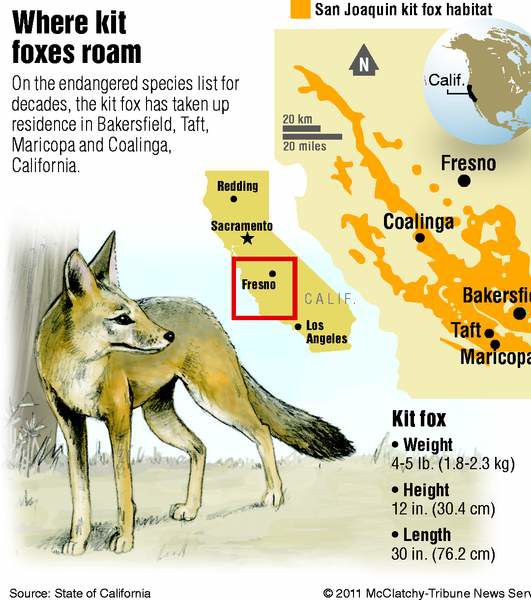Endangered urban kit foxes thriving on human diet
Published 4:00 am Wednesday, February 2, 2011

- Endangered urban kit foxes thriving on human diet
FRESNO, Calif. — Scientists have long known that endangered San Joaquin kit foxes live in Bakersfield, raiding Dumpsters for half-eaten hot dogs, doughnuts and burritos.
Now it turns out that this critter has adapted to city life, eating an essentially human diet — and thriving.
The kit fox — protected in the 1960s even before the Endangered Species Act — grows bigger and lives longer than foxes in the wild. The only downside for these city-dwelling foxes is high cholesterol.
A study, published in December in the Journal of Mammology, revealed the surprising results, said Bryan Cypher, research ecologist and kit fox expert in Bakersfield for the last 20 years.
“We just didn’t know they were eating human food to this extent,” said Cypher, who works for the Endangered Species Recovery Program at California State University, Stanislaus, and took part in the new research.
It’s not what the Endangered Species Act envisions for species recovery. For decades, the kit fox population has been decimated throughout the San Joaquin Valley. Cypher estimated 80 percent to 90 percent of its native habitat disappeared with the spread of agriculture and cities.
He said the kit fox needs corridors of natural habitat through Valley development and agriculture to link them with remaining wild lands. The animals need to move throughout the region and build up numbers again, he said.
But as the species suffers, several hundred kit foxes fatten up eating human goodies in addition to gophers and ground squirrels, much like their counterparts in native Valley habitat. The kit foxes in the wild also eat more rodents, like the kangaroo rat.
To compare diets, researchers tested hair samples from Bakersfield residents, city kit foxes and kit foxes in the wild.
Researchers said molecular characteristics of hair on mammals — including humans — reflect what has been eaten over a long period of time. The city-dwelling fox diets were a pretty close match with humans in Bakersfield, according to the findings by animal ecologist Seth Newsome of the University of Wyoming.
The city offers them refuge from primary predators — bobcats and coyotes. In Bakersfield, the kit fox is killed more often by cars and poisons meant for rodents.
Bakersfield has the biggest population of these animals, but they also are found in Taft, Maricopa and Coalinga. The fox is a Mojave Desert species that prefers opens spaces in the southern and western parts of the Valley.
The fox is able to establish itself in Valley cities where the natural habitat connects with the city’s outskirts, Cypher said. In Bakersfield, it’s the east side of town.
But around many cities, such as Fresno or Hanford, surrounding farms have altered the native land, often destroying burrows and preventing kit foxes from easy access to the city.
People might mistakenly think they have seen a kit fox in Fresno, Cypher said. Most of the time, they are seeing the gray fox, another native species that looks a lot bushier, he said. A non-native red fox, transplanted decades ago in California by hunters, also is seen around cities, he said.
Unlike many animals, kit foxes can adapt to city living, readily using canal banks, parks and even school fields to live. They don’t need a lot of space, and they seem willing to inspect and try different foods. Bakersfield residents seem to like them, too.
“People living along golf courses sometimes put out cat food for them,” Cypher said. “It’s illegal to feed an endangered species. But the cat food does help them get a more balanced diet.”






